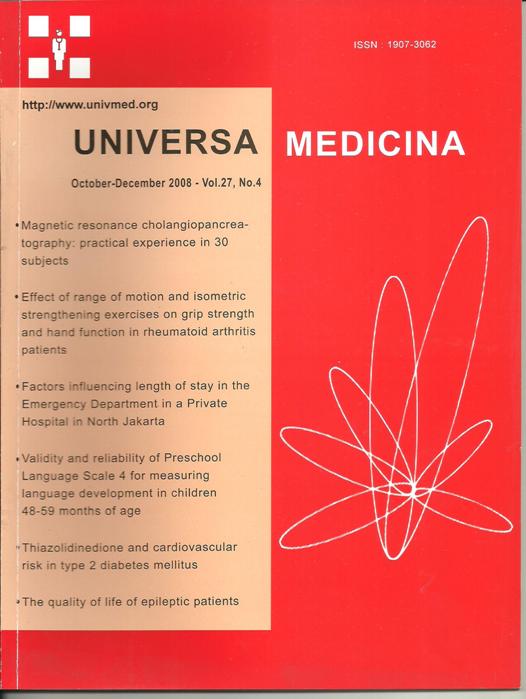Magnetic resonance cholangiopancreatography: practical experience in 30 subjects
Main Article Content
Abstract
Article Details
Issue
Section
The journal allows the authors to hold the copyright without restrictions and allow the authors to retain publishing rights without restrictions.
How to Cite
References
Mac Eneaney P, Mitchell MT, Mc Dermoth R. Update on magnetic resonance cholagio pancreatography. Gastroenterol Clin N Am 2002; 31: 731-46.
Ballinger PW, Frank ED. Biliary tract and gallbladder. In: Merrill’s atlas at radiographic position and radiologic procedures. Vol. II. Missouri: Mosby; 2003. p. 69-116.
Karani J. The biliary tract. In: Sutton D, editor. Textbook of radiology and imaging. Vol.1. London: Churchill Livingstone; 2003. p. 711-36.
Shanmugam AV, Beattie GC, Yule SR, Reid W, London MA. Is magnetic resonance cholangiopancreatography the new goldstandard in biliary imaging ? Br J Radiol 2005; 78: 888-93.
Wallner BK, Schumacher KA, Weidenmaier W, Friedrich JM. Dilated biliary tract: evaluation with magnetic resonance cholangiopancreatography with a T2-weighted contrast-enhanced fast sequence. Radiology 1991; 18: 805-8.
Mougenel JL, Hudziak H, Ernst O. Evaluation of a new sequence of magnetic resonance cholangio-pancreatography in thick cut and one shot acquisition. Gastroenterol Clin Biol 2000; 24: 888–95.
Gallix BP, Régent D, Bruel JM. Use of magnetic resonance cholangiography in the diagnosis of choledocholithiasis. Abdom Imaging 2001; 26: 21–7.
Topal B, Van de Moortel M, Fieuws S, Vanbeckevoort D. The value of magnetic resonance cholangio pancratography in predicting common bile duct stones in patients with gallstone disease. Br J Surg 2003; 90: 42–7.
Wijaya PM. Magnetic resonance cholangiopancrea- tography for biliary obstruction. 7th Hepatobiliary Surgical Update and Workshop on Therapeutic Endoscopy. Jakarta; 2006.
Barrish MA, Yuccel EK, Ferrucci JT. Magnetic resonance cholangio pancreatography. N Engl J Med 1999; 341: 258-64.
Calco MM, Bufanda L, Calderon A, Heras I, Cabriada JL, Bernal A, et al. Role of magnetic resonance cholangiopancreatography in patients with suspected choledocholithiasis. Mayo Clin Proc 2002; 77: 422-8.
Romagnuolo J, Bardon M, Rahme E, Joseph L, Reinhold C, Barkun AN. Magnetic resonance cholangiopancreatography: a meta analysis of test performance in suspected biliary disease. Ann Inter Med 2003; 139-7: 547-57.
Kaltenhaler E, Vergel YB, Chilcot J, Thomas S, Blakeborough T, Walters SJ, et al. A systemic review and economic evaluation of magnetic resonance cholangiopancreatography compare with diagnostic endoscopic retrograde cholangiopan-creatography. Health Technology Assessment; 2004. Availabe at: http://www.hta.ac.uk/exec.summ /summ810.htm. Accessed August 1, 2008.
Leung J. Fundamentals of ERCP, in advanced digestive endoscopy: endoscopic retrograde cholangiopancreatography. In: Cotton PB, Leung J, editors. 1st Ed. Massachusets: Blackwell Publishing; 2006. p. 17-80.
Georgopulos SK, Schwartz LH, Jarnagin WR, Gerdes H, Breite I, Fong Y, et al. Comparison of magnetic resonance and endoscopic retrograde cholangiography in malignant pancreaticobiliary obstruction. Arch Surg 1999; 134: 1002-7.
Fulcher AS,Turner MA, Capps GW, Zfass AM, Baker K. Half-Fourier RARE magnetic resonance cholangiopancreatography: experience in 300 subjects. Radiology 1998; 207: 21-32.
Williams EJ, Green J, Beckingham I, Park R, Martin D, Lombard M. Guidelines of the management of common bile duct stones. GUT 2008; 57: 1004-21.


